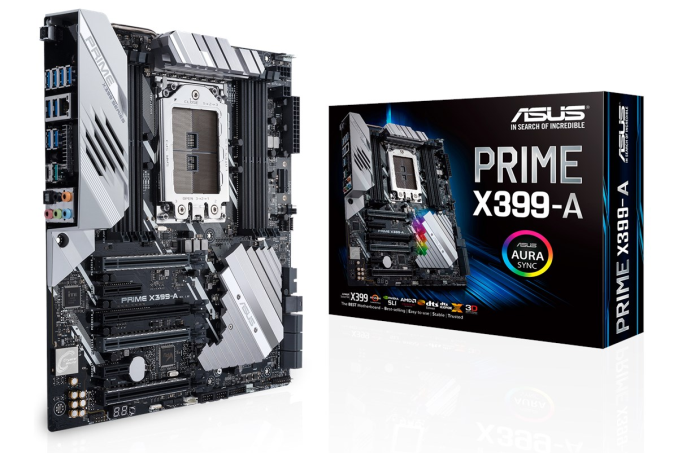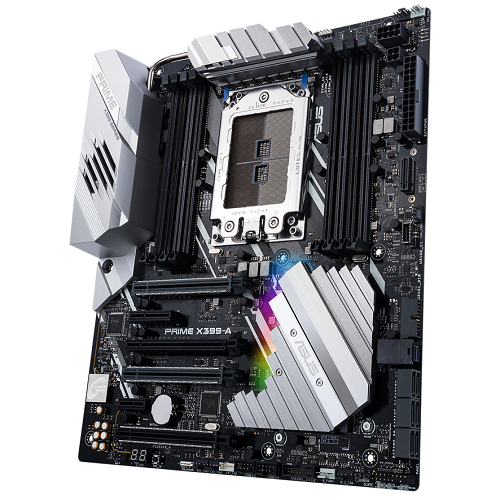An AMD Threadripper X399 Motherboard Overview: A Quick Look at Seven Products
by Ian Cutress & Joe Shields on September 15, 2017 9:00 AM ESTASUS Prime X399-A
By contrast to the comparison between the two ASRock motherboards, ASUS has positioned their first two products further apart from each other. The Prime X399-A is aimed more at an entry into X399, although the ‘entry’ moniker might be misleading: these X399 motherboards are still being stacked to the hilt in functionality even for the ‘cheaper’ models.
The ASUS Prime X399-A follows previous Prime-A products in a white/grey styling, using a brushed metal and angled design across the heatsinks and PCB to show that this motherboard means business (or something like that). The key features of the Prime X399-A are going to be the extended power delivery heatsink arrangement, U.2 and M.2 storage support, ASUS’ upgrade to the Realtek audio and RGB support.
The baseline specifications for the majority of Threadripper boards are here: a full complement of 8 DIMMs for memory, a good set of PCIe slots for multiple-add in cards, SATA storage, Ethernet and USB 3.1 (10 Gbps) support. ASUS, by comparison to the ROG Zenith, has stripped this model down: there’s only one Ethernet port, no WiFi, only two M.2 slots, fewer USB ports (but still over a dozen), and fewer PCIe slots with reinforcement. Threadripper is a high-end product, so doing a complete strip down to the bare essentials negates the high-end aspect of the platform. Perhaps a surprise over the ROG is that the Prime-A has a two-digit LED debug, while the ROG does not.
Going through the board in detail, starting at the top, is the VRM arrangement. This is an eight-phase design, with a dual connected heatsink reaching around the memory slots to the rear panel, which has a small 40mm fan. On the other side of the socket, ASUS has placed both EPS connectors (one 8-pin, one 4-pin) on the top right of the board with the 24-pin ATX connector directly below. While this area is where ASUS normally places some of its more esoteric features, such as PCIe slot disabling switches, there is no need to here. Perhaps a little strange to most will be the placement of the M.2 slot underneath the 24-pin, which requires the M.2 be placed ‘standing-up’ and out of the board. ASUS provides an M.2 bracket to assist in rigidity here.
Below the M.2 is the onboard USB 3.1 (10 Gbps) header from the chipset, which is slowly becoming adopted as the onboard standard, with a small number of chassis manufacturers adopting it for adding front-panel ports. This is followed by one of the two USB 3.0 headers, a U.2 port, and six SATA ports.
The chipset heatsink, as shown by the RGB on the picture, houses a few LEDs to adjust the aesthetic through the onboard AURA SYNC software. The heatsink also houses an M.2 slot, like the ROG, and helps provide additional cooling for it if needed.
To the left of the chipset are the PCIe slots. In order to save some cost and provide a little bit of product differentiation, ASUS has decided to only equip three of the full-length slots with a reinforcement guard, although all four full-length slots are connected to the CPU. The full length slots are provided as x16/x8/x16/x8, and when users equip multiple graphics cards, the slots with the reinforcement guard are the best ones to use. The one without the guard is not worse in any way, however in a two or three card system, using x16/x16 or x16/x16/x8 is usually preferred to x16/x8 or x16/x8/x8 due to the slot spacing arrangement. There is an additional PCIe 2.0 x4 from the chipset present as well.
Below the PCIe slots are the onboard headers, including USB 3.0 headers, fan headers, RGB LED headers and a two-digit debug. This is also paired with a power button to test the motherboard when a hand is in the case but the case is not hooked up. To the right of this is the onboard audio, to which ASUS uses their customized version of the Realtek ALC1220. This is combined with upgraded filter caps, PCB separation, an EMI shield and a DTS software stack.
The rear panel, due to the positioning of the board, might look a little bare compared to the ROG. There is the BIOS reset button, a total of eight USB 3.0 ports, the gigabit Ethernet port provided via the Intel I211-AT controller, a USB 3.1 Type-A port and Type-C port from an ASMedia controller, and the audio jacks with SPDIF output.
| ASUS Prime X399-A | |
| Warranty Period | 3 Years |
| Product Page | Link |
| Price | $349.99 |
| Size | E-ATX |
| CPU Interface | TR4 |
| Chipset | AMD X399 |
| Memory Slots (DDR4) | Eight DDR4 Supporting 128GB Quad Channel Up to 3600 MHz (OC) |
| Network Connectivity | 1 x Intel I211-AT GbE |
| Wireless Network | N/A |
| Onboard Audio | SupremeFX S1220A |
| PCIe Slots for Graphics (from CPU) | 4 x PCIe 3.0 x16 Supports SLI/CF |
| PCIe Slots for Other (from Chipset) | 1 x PCIe 2.0 x4 (max) 1 x PCIe 2.0 x1 |
| Onboard SATA | 6x Supporting RAID 0/1/10 |
| Onboard SATA Express | None |
| Onboard M.2 | 2 x PCIe 3.0 x4 - NVMe or SATA |
| Onboard U.2 | 1 x |
| USB 3.1 | 1 x Type-A Port 1 x Type-C Port |
| USB 3.0 | 8 x Rear Panel Ports 2 x Headers |
| USB 2.0 | 2 x Headers |
| Power Connectors | 1 x 24-pin EATX 1 x 8-pin ATX 12V 1 x 4-pin ATX 12V |
| Fan Headers | 1 x M.2 1 x CPU 1 x CPU OPT 3 x Chassis 1 x AIO_PUMP 1 x 5-pin EXT_FAN |
| IO Panel | 1 x Intel NIC 1 x USB 3.1 Type-A 1 x USB 3.1 Type-C 8 x USB 3.0 Ports 1 x Optical S/PDIF out 5 x Audio jack 1 x USB BIOS Flashback Button |













99 Comments
View All Comments
HStewart - Friday, September 15, 2017 - link
You got to give some credit to AMD clever marketing teams by naming this x399 when Intel has x299 and then calling this the "The Most Advanced Desktop Motherboard in the World"But in reality there is no Thunderbolt 3.0 support and most likely be updated next year or later with PCIe 4.0 support.
Does it support DDR4-4600?
AMD sure likes to play numbers game and not just chipset name - but with number cores - just remember it mostly marketing - yes it still 16 cores - but 16 cores by one manufacturer does not mean 16 cores from completion.
sartwell - Friday, September 15, 2017 - link
Where is the high speed RAM? You cannot get it anywhere.HowardJones - Friday, September 15, 2017 - link
If you're considering the ROG Zenith be aware that it's having tons of problems overclocking CPU and memory. Theres a huge thread on overclock dot net that is filled with people having problems with the bios. There WAS an Asus rep who was trying to help, but he's pretty much disappeared in the last few weeks.tamalero - Sunday, September 17, 2017 - link
Seems like your average typical Asus mainboard.Asus has really huge troubles in their software segment. I still remember they needed like 50 patches to get their high end routers stable. And yet they couldnt get all what they promised in a working condition and even disabled some stuff in later firmwares.
Same with bioses.
I still remember a time where you had to enable the "floppy" connector in a motherboard (even if you had no drive) if you wanted the bios to actually apply the overclocking settings.
mapesdhs - Tuesday, September 19, 2017 - link
A note for those with older ASUS ROG and other ASUS X79 boards, etc.: there's a thread on the ASUS ROG forum site where a guy has provided modded BIOS files to support booting from NVMe devices, aswell as rolling in all the updates to the latest microcode, Intel RAID, etc. Very handy indeed, and he takes requests for other ASUS boards. SSDs like the 950 Pro have their own boot ROM, but a BIOS with boot support is perfect for the 960 EVO/Pro and other models which don't have their own boot ROM.I just bought two R4Es (one basically new), a 4930K, a 16GB/2400 DDR3 kit and a 120mm AIO for a total of 320 UKP. Who needs new stuff? :D My next new build will be TR or EPYC though I'm sure.
satai - Saturday, September 16, 2017 - link
Are any details on X399 AORUS Gaming 7 power delivery solution?The rumor was, that the used only 8 phase, but 8s this true for the final design?
danjw - Saturday, September 16, 2017 - link
The Asus Zenith Extreme claims to support 4-way SLI, but I thought Nvidia didn't support 4x slots for SLI? Am I wrong? Or is this a false claim?DanNeely - Saturday, September 16, 2017 - link
Cynically I'm going to guess that if you use several generation old cards that did support 4 way SLI you could combine all 4 together for an act of supreme WTFery.danjw - Saturday, September 16, 2017 - link
I looked at the manual for the Zenith Extreme. It claims the two that the block diagram of the board in this review indicates are 4x are 8x, with the lowest one on the board being 8x as long as you don't have a U.2 drive connected to the U.2 port. So, it is unclear which is correct the block diagram or the manual.danjw - Sunday, September 17, 2017 - link
Apparently, the block diagram wasn't clear. That last slot is 8x/4x depending on if you have a U.2 drive connected.